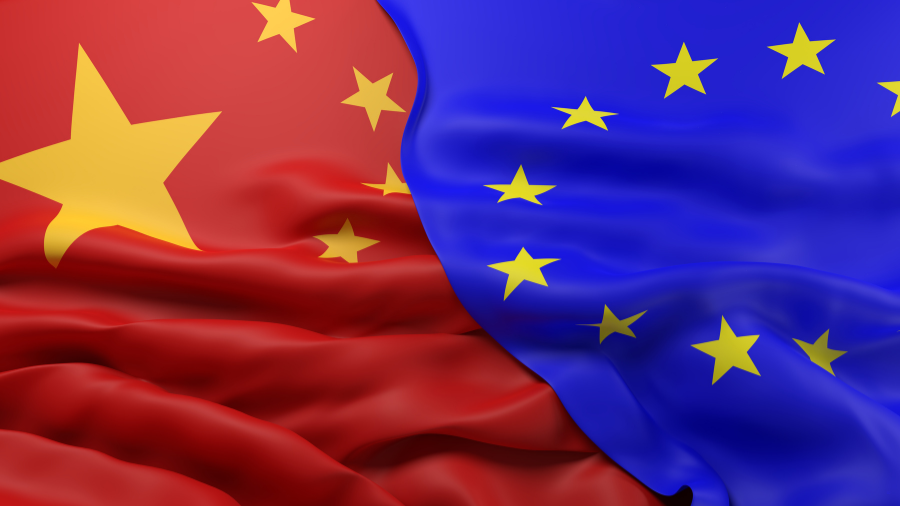Economy & Trade
China’s Economy Beats Expectations in Q1 2025 - Can Momentum Last?
04/16/2025While strong export growth helped China’s economy beat expectations in Q1 2025, the impact of US tariffs may test its resilience. We look at China's latest economic indicators.
Impact of US-China Tariffs on Transfer Pricing - Considerations for MNCs
04/14/2025The escalating global trade war has profound implications for transfer pricing. We discuss strategies for MNCs to mitigate risk exposure.
US-China Relations in the Trump 2.0 Era: A Timeline
04/14/2025On April 2, 2025, President Donald Trump announced a comprehensive overhaul of US trade policy, introducing significant tariffs on imports from various countries. Chinese imports will face an additional 34 percent tariff on top of the existing 20 percent, culminating in a total tariff rate of 54 percent.
Trump Raises Tariffs on China to 145% - Overview and Trade Implications
04/11/2025Trump's latest tariff hike will place significant pressure on Chinese exporters, but has the potential to reshape global trade relations.
US Trump Tariffs: Key Implications for China's Ultra-Fast Fashion
04/11/2025US Trump Tariffs, reinstated in April 2025, revoked the de minimis exemption for Chinese shipments, introducing new tariffs on small packages and bulk imports. This shift threatens China’s ultra-fast fashion sector, by raising operational costs and disrupting their business model based on low-value, high-frequency shipments.
EU-China Relations After the 2024 European Elections: A Timeline
04/11/2025Timeline tracking key developments affecting EU-China relations, including trade and business engagement, under the new European Parliament.
-
04/10/2025
China’s 2025 Outbound Investment: Key Markets & Sector Trends
China Briefing -
04/10/2025
Will Trumps’ New 145% China Import Tariffs Increase China’s BRICS Trade?
China Briefing -
04/07/2025
China-Peru Trade 2.0: What the Future Holds under the Upgraded FTA
China Briefing -
04/06/2025
China-Ecuador Economic Ties and Trade Prospects
China Briefing -
04/04/2025
China Outbound Direct Investment (ODI) Tracker: 2024-25
China Briefing
Tax & Accounting
Impact of US-China Tariffs on Transfer Pricing - Considerations for MNCs
04/14/2025The escalating global trade war has profound implications for transfer pricing. We discuss strategies for MNCs to mitigate risk exposure.
Selecting Compliant Providers: Understanding China’s 2025 Tax Service Regulations
04/11/2025China’s 2025 tax service regulations introduce a credit code and intelligent supervision for professional tax services. Discover how the new rules impact businesses and get practical tips for selecting compliant tax service providers.
China Monthly Tax Brief: March 2025
04/04/2025In this monthly China tax brief for March 2025, we spotlight policies and measures just announced or scheduled for implementation.
China Updated Certificate of Tax Residency Rules: Key Changes Effective April 2025
03/27/2025China has updated the Certificate of Tax Residency rules, effective April 1, 2025. The changes introduce a fully digital application process, reduce processing time, and expand the certificate’s scope for tax treaty benefits and verification.
China Manufacturing Tracker: 2024-25
03/27/2025Our tracker provides continuous updates on key economic and growth indicators in China’s manufacturing industry. The data for January and February 2025 has now been updated partially.
China Annual IIT Reconciliation in 2025: Everything You Need to Know
03/21/2025Annual IIT reconciliation for the year 2024 is required to be made during the period from March 1 to June 30, 2025. Starting from March 21, taxpayers can make the final tax settlement directly without requiring a prior appointment.
-
03/18/2025
Navigating Hong Kong’s Annual Employer’s Return: Compliance and Best Practices
China Briefing -
03/13/2025
Hainan Renews Preferential CIT and IIT Policies, Bolstering Free Trade Port Competitiveness
China Briefing -
03/06/2025
China Monthly Tax Brief: February 2025
China Briefing -
02/24/2025
The Annual IIT Reconciliation in China in 2025: Appointment Booking Opens February 21
China Briefing -
02/19/2025
Managing Tax Compliance Risks in China: Fraudulent Invoicing and Misuse of Tax Incentives
China Briefing
Legal & Regulatory
China's Social Credit System Raises Stakes for Dishonest Businesses
04/15/2025China’s latest guidelines on strengthening the social credit system impose stricter penalties on dishonest businesses. Entities labeled as seriously dishonest face restrictions on government funding, tax breaks, and market access.
Selecting Compliant Providers: Understanding China’s 2025 Tax Service Regulations
04/11/2025China’s 2025 tax service regulations introduce a credit code and intelligent supervision for professional tax services. Discover how the new rules impact businesses and get practical tips for selecting compliant tax service providers.
China’s Cybersecurity Law Amendments: Key Changes in the Second Draft
04/01/2025China’s latest Cybersecurity Law amendments introduce stricter compliance requirements, higher penalties, and enhanced enforcement for businesses. Learn how these changes impact businesses and what companies must do to stay compliant.
China's Tightened Facial Recognition Regulations: Key Business Takeaways
03/31/2025China's new facial recognition regulations, effective June 1, 2025, impose stricter compliance rules on businesses, requiring justification for use, enhanced data security, and transparency. Learn what your company needs to do to stay compliant.
The EU Simplifies CBAM and Sustainability Reporting Rules - Impact on Chinese Companies
03/26/2025The EU has simplified CBAM and sustainability reporting rules, reducing compliance burdens for businesses. Learn how these changes impact Chinese companies operating in or exporting to the EU.
What are Company Health Checks, and Why Do Foreign Companies in China Need one in 2025?
03/20/2025A company health check in 2025 can help businesses identify risks, ensure compliance, and optimize operations. Learn why proactive assessments are essential for long-term success.
-
03/19/2025
China Briefing
-
03/12/2025
Eco-Tech Revolution: China's 2025 Blueprint for Sustainable Innovation
China Briefing -
03/10/2025
The Policies Shaping China’s Industry Landscape in 2025
China Briefing -
03/04/2025
Shanghai Streamlines Data Export with New Data Negative List
China Briefing -
03/03/2025
China Industries to Watch in 2025: Tapping into Growth Opportunities
China Briefing
Industries
US Trump Tariffs: Key Implications for China's Ultra-Fast Fashion
04/11/2025US Trump Tariffs, reinstated in April 2025, revoked the de minimis exemption for Chinese shipments, introducing new tariffs on small packages and bulk imports. This shift threatens China’s ultra-fast fashion sector, by raising operational costs and disrupting their business model based on low-value, high-frequency shipments.
Investing in the Future: Opportunities in China’s Humanoid Robotics and Embodied AI Industry
04/07/2025China's humanoid robot market is expected to become a multi-billion dollar industry within the next decade, presenting huge opportunities for investors in a variety of sectors.
China Manufacturing Tracker: 2024-25
03/27/2025Our tracker provides continuous updates on key economic and growth indicators in China’s manufacturing industry. The data for January and February 2025 has now been updated partially.
China Ultra-Fast Fashion Sector: Growth, Challenges, and the Global Impact of the “Shein Effect”
03/25/2025China continues to dominate the ultra-fast fashion industry through efficient production, AI-driven trends, and cross-border e-commerce, but faces growing challenges in sustainability, labor practices, and regulatory compliance.
Eco-Tech Revolution: China's 2025 Blueprint for Sustainable Innovation
03/12/2025This article explores how scientific and technological innovation is shaping the future of environmental protection in China, highlighting key developments, government initiatives, and the potential impact on businesses and society.
The Policies Shaping China’s Industry Landscape in 2025
03/10/2025China’s policy-driven initiatives will shape its industrial trajectory in 2025, driving growth through domestic demand, innovation, and sustainability.
-
03/03/2025
China Industries to Watch in 2025: Tapping into Growth Opportunities
China Briefing -
02/26/2025
China’s Fertility Services Market: Navigating Growth, Challenges, and Opportunities
China Briefing -
02/17/2025
Navigating China’s Industry Priorities: Insights from 2024 Tax Cuts and Incentives
China Briefing -
02/10/2025
China's Electronic Manufacturing: 2024 Performance Review and 2025 Outlook
China Briefing -
02/04/2025
China’s Space Economy: Unlocking Opportunities in Aerospace and Commercial Space Industries
China Briefing
HR & Payroll
Navigating China’s Evolving Labor Market in 2025
04/09/2025China's labor market is transforming rapidly in 2025, driven by demographic shifts, evolving workplace preferences, and technological advancements. This article explores the trends and challenges in maintaining a sustainable workforce.
A Guide to Minimum Wages in China (As of April 7, 2025)
04/07/2025This article offers a guide to minimum wages in the Chinese Mainland and discuss how labor costs are affected by changes to the minimum wage levels. The data is current as of March 21, 2025.
Hong Kong Abolishes MPF Offsetting: What Employers Need to Know
04/02/2025Hong Kong government will implement the Abolition of the MPF Offsetting Arrangement starting May 1, 2025. Learn how businesses can stay compliant, manage costs, and apply for government subsidies.
From Recruitment to Retention: Talent Trends and Strategies in China
03/24/2025In this issue of China Briefing Magazine, we examine how demographic shifts, technological advancements, and regulatory reforms are reshaping employment practices across the country and offer localized strategies for attracting and retaining talent in this dynamic market.
Navigating Hong Kong’s Annual Employer’s Return: Compliance and Best Practices
03/18/2025The Annual Employer’s Return filing in Hong Kong begins on the first working day of April and should be completed within one month. Employers are advised to start preparations early and allocate sufficient resources to meet this tight deadline.
Exploring the Rise of Women in China's Workforce: Statistics and Progress in Gender Equality
03/08/2025This article examines the significant progress made in gender equality across various dimensions of China’s labor market, as well as fair policies and best practices of female employee management in China.
-
02/25/2025
Conducting a Company Health Check in China 2025: Essential Steps and Checklists
China Briefing -
02/24/2025
The Annual IIT Reconciliation in China in 2025: Appointment Booking Opens February 21
China Briefing -
02/11/2025
China’s Labor Law: Trends to Watch in 2025
China Briefing -
02/10/2025
China's Visa-Free Policies: Latest Updates
China Briefing -
01/16/2025
Preparing for Chinese New Year 2025: Essential Tips for Businesses
China Briefing
Technology
EU-China Relations After the 2024 European Elections: A Timeline
04/11/2025Timeline tracking key developments affecting EU-China relations, including trade and business engagement, under the new European Parliament.
Investing in the Future: Opportunities in China’s Humanoid Robotics and Embodied AI Industry
04/07/2025China's humanoid robot market is expected to become a multi-billion dollar industry within the next decade, presenting huge opportunities for investors in a variety of sectors.
China’s Cybersecurity Law Amendments: Key Changes in the Second Draft
04/01/2025China’s latest Cybersecurity Law amendments introduce stricter compliance requirements, higher penalties, and enhanced enforcement for businesses. Learn how these changes impact businesses and what companies must do to stay compliant.
China's Tightened Facial Recognition Regulations: Key Business Takeaways
03/31/2025China's new facial recognition regulations, effective June 1, 2025, impose stricter compliance rules on businesses, requiring justification for use, enhanced data security, and transparency. Learn what your company needs to do to stay compliant.
Shanghai Streamlines Data Export with New Data Negative List
03/04/2025Shanghai's new data export negative list facilitates cross-border data transfers for companies in reinsurance, shipping, and commerce in the Pilot Free Trade Zone and Lingang New Area.
Personal Information Protection Audits in China: Final Measures Effective May 1
02/20/2025China’s Cyberspace Administration has unveiled the final rules on conducting personal information protection audits. The new measures, which require fewer companies to conduct less frequent audits than the draft version, offer an opportunity for businesses to strengthen compliance.
-
02/04/2025
China’s Space Economy: Unlocking Opportunities in Aerospace and Commercial Space Industries
China Briefing -
01/30/2025
China Robotics Industry: What Are the Opportunities for Foreign Stakeholders
China Briefing -
01/10/2025
China Briefing
-
12/09/2024
New Guide for Cross-Border Personal Data Transfers in the GBA: A Roadmap for Compliance and Security
China Briefing -
12/09/2024
US-China Relations in the Biden Era: A Timeline
China Briefing
 Our firm Dezan Shira & Associates provides legal, tax and operational advisory across Asia.
Our firm Dezan Shira & Associates provides legal, tax and operational advisory across Asia. 





























